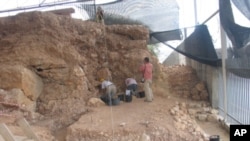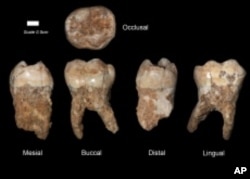Israeli archeologists have discovered ancient artifacts in a cave outside of Tel Aviv that could shed new light on the theory of human origins. Tel Aviv University archeologist Ran Barkai says what his team has excavated at Qesem Cave show a much more advanced people than the accepted image of our Stone Age ancestors in the Middle Paleolithic period.
These early hominids hunted for food, cooked meat over fires and crafted a sophisticated array of flint tools.
"We know that they had a set of different knives, almost like a modern butcher, that they used in the cave in order to cut the meat and eat it. And, we even have what we call Paleolithic cutlery. We have very small knives that we suggest were used while eating," Barkai says, adding that the tools are all remarkably well preserved. "They look like new, like they were made yesterday."
The archeologists also found human teeth in different strata in the cave. Barkai says scholars and dental anthropologists from Europe and the United States joined the Israelis to analyze the dental samples.
"It was clear from the comparison that the human teeth from Qesem Cave resembled most of the teeth of homo sapiens that lived in Israel much later, at an age of 100,000 years before present, at two caves, one in the Galilee and one in the Carmel."
According to a widely accepted scientific theory, modern humans emerged from Africa around 200,000 years ago. Barkai says the teeth in Qesem Cave would predate those early human migrants. "We think that we are right. It is still only eight teeth or 10 teeth. So we need more evidence. It might imply that during this phase, maybe even a new hominid was living and this is another link or piece of the chain leading to modern humans."
According to New York University paleo-dental anthropologist Shara Bailey, it may also represent another step in the evolution of man’s ancient human relatives, the Neanderthals, who lived in Europe and Asia around 200,000 years ago.
"My take on it is that these teeth are quite primitive. There is nothing in the morphology of these teeth that looks like homo-sapiens at all," says Bailey. "In fact it looks primitive and if anything it looks a little bit Neanderthal like."
In a recent article in the American Journal of Physical Anthropology, Barkai and his team suggest three theories: the Qesem teeth could belong to earlier humans or homo sapiens that developed independently from those in Africa and Europe. They could, as Shara Bailey suggests, represent an evolving Neanderthal in Southwest Asia. Or they could be from unknown extinct hominid species.
But Bailey says whether the residents of Qesem Cave were like us or not, does not make the discoveries any less important. "Any new material that we find, especially from this poorly documented time period 200,000 to 400,000 years ago, is great and necessary for our ongoing interpretation of human evolution and Neanderthal evolution."
Israeli archeologist Barkai expects Qesem Cave will continue to yield magical artifacts. He and his team from Tel Aviv University hope to find bones to add to the story of our ancient ancestors.
New York University paleo-dental anthropologist Shara Bailey explains what can be learned from the teeth of our ancient ancestors.










